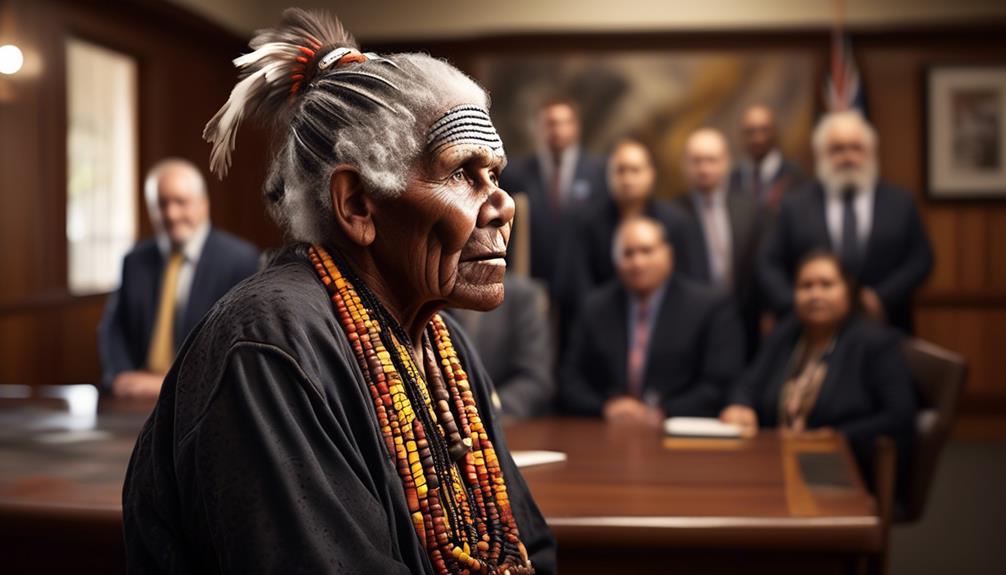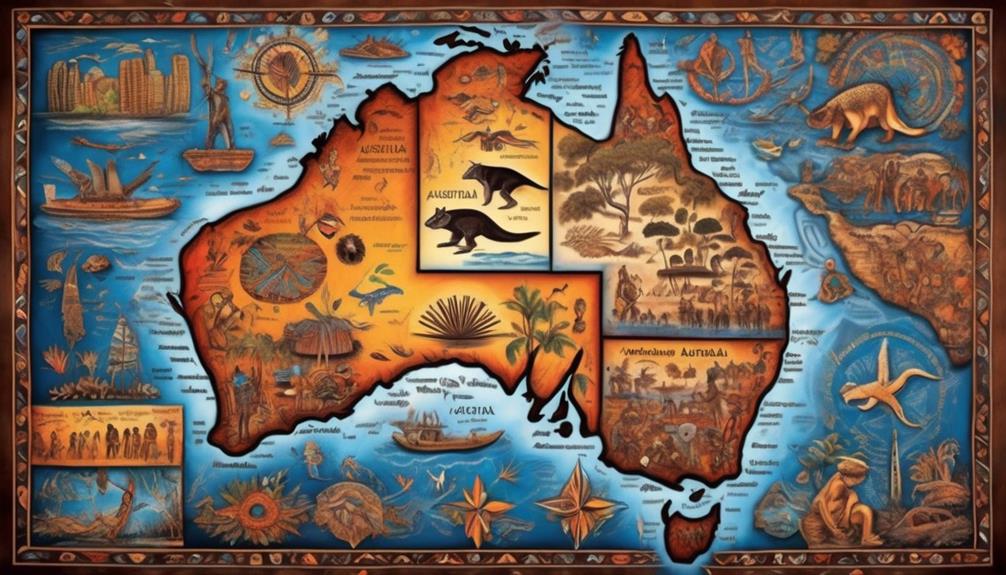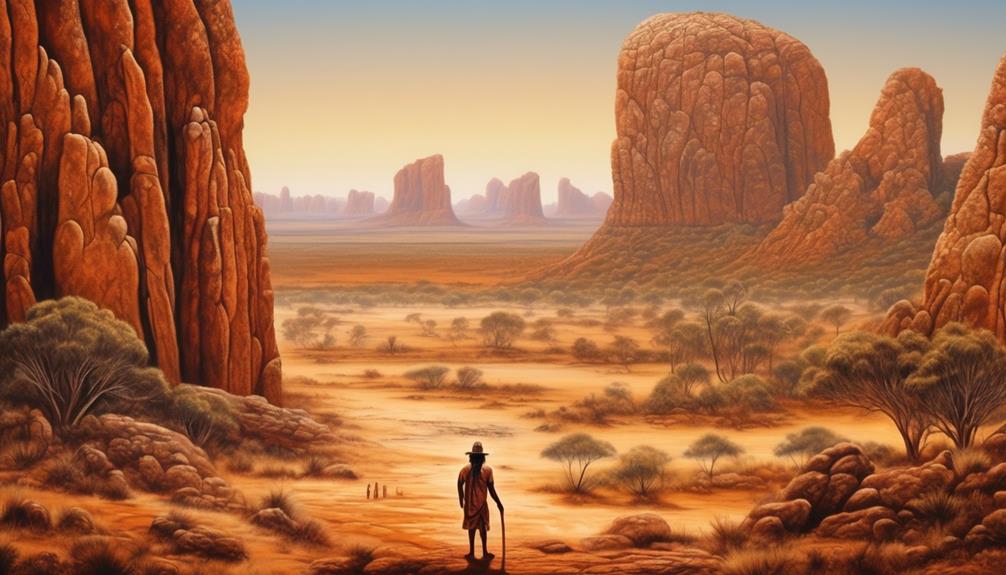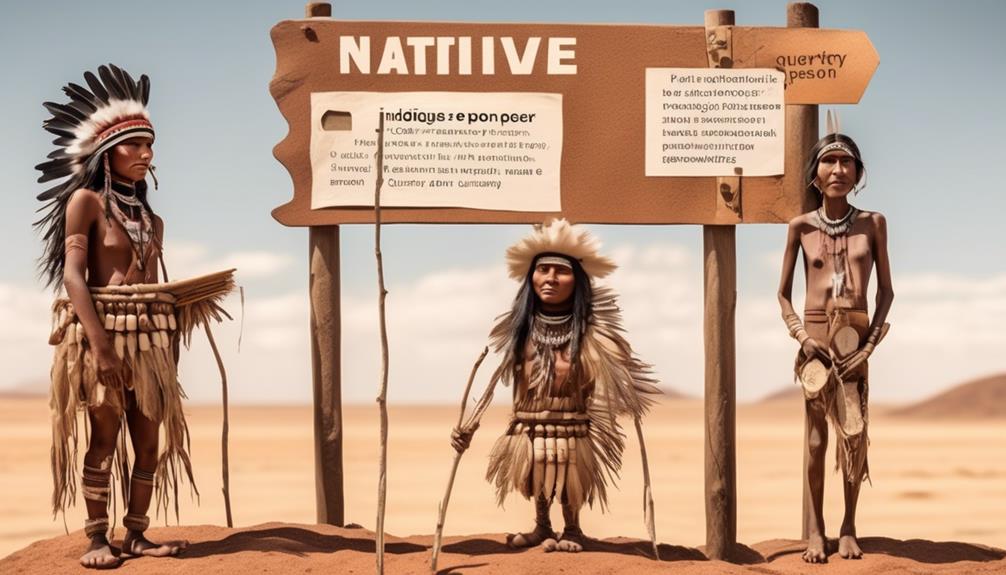Have you ever wondered about the symbols utilized by Indigenous Australians? These symbols convey a complex system of communication, rich with historical significance and deep meaning, waiting to be explored.
Understanding these symbols opens the door to a deeper understanding of the Aboriginal culture and their connection to the land.
As you explore the significance of these symbols, you will uncover a world of tradition, spirituality, and artistry that continues to captivate and inspire.
Key Takeaways
- Aboriginal symbols have origins dating back thousands of years and are deeply rooted in the cultural and spiritual traditions of Indigenous peoples.
- These symbols serve as a visual language, communicating stories, customs, and the deep spiritual connection Aboriginal communities have with the land.
- Traditional meanings of these symbols vary among different Aboriginal groups and are tied to specific geographic regions and cultural practices.
- Understanding and appreciating these symbols is crucial in gaining insight into Aboriginal traditions, beliefs, and the passing down of ancestral knowledge, history, and wisdom.
Origins of Aboriginal Symbols
What are the origins of the diverse symbols used by Aboriginal communities?
The origins of Aboriginal symbols can be traced back thousands of years and are deeply rooted in the rich cultural and spiritual traditions of Indigenous peoples. These symbols aren't merely decorative; they hold deep traditional meanings and are used to convey important stories, beliefs, and knowledge passed down through generations. Each symbol is a reflection of the unique experiences and connections to the land and nature that Aboriginal communities have cultivated over centuries.
Traditional meanings associated with these symbols vary among different Aboriginal groups and are often tied to specific geographic regions and cultural practices. For example, the symbol of the 'Rainbow Serpent' in Aboriginal art represents creation, fertility, and the cycle of life, while the 'Kangaroo Tracks' symbolize the presence of kangaroo and the abundance of food. These symbols serve as a visual language, allowing Indigenous peoples to communicate and preserve their cultural heritage.
Understanding the origins and traditional meanings of these symbols is crucial in appreciating the depth and significance of Aboriginal art and culture.
Key Aboriginal Symbols and Their Meanings
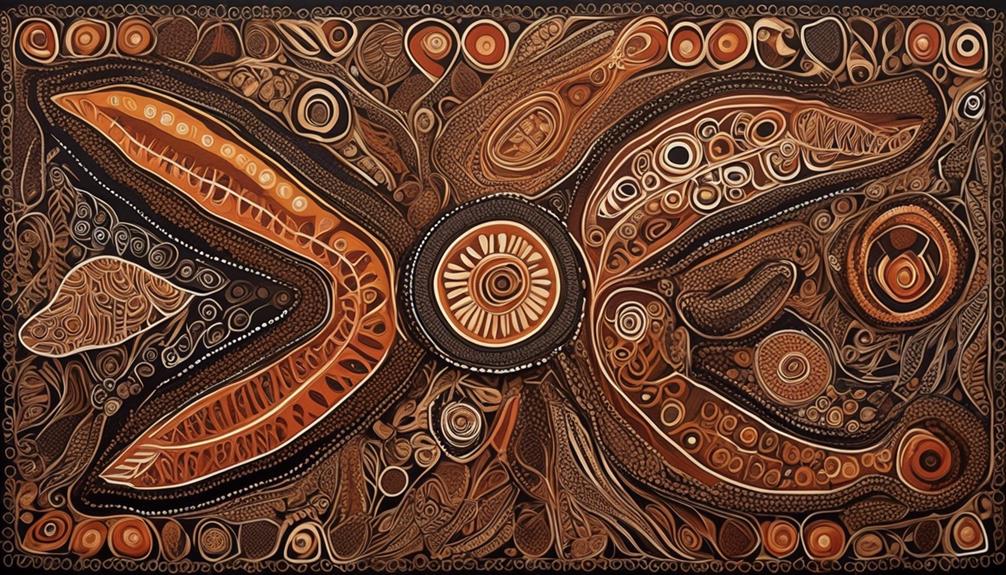
The traditional meanings and significance of Aboriginal symbols are deeply intertwined with the cultural and spiritual traditions of Indigenous peoples, paving the way for a closer examination of key symbols and their meanings in Aboriginal art and culture. When exploring the key Aboriginal symbols and their meanings, you'll find that they often convey rich stories and traditions that have been passed down through generations.
Here are some key Aboriginal symbols and their meanings:
- Dot Painting: This iconic form of Aboriginal art is often used to represent elements of nature and traditional storytelling. Each dot in the painting carries specific meanings and can depict various aspects of the natural world.
- Animal Tracks: In Aboriginal art, animal tracks are often used to symbolize the presence of specific animals and their significance in traditional storytelling.
- Waterholes: Depicted as concentric circles, waterholes symbolize a vital source of life and are often associated with spiritual significance in Aboriginal culture.
- Contemporary Interpretation: While traditional Aboriginal symbols hold deep cultural meanings, contemporary Aboriginal artists also infuse modern themes and interpretations into their art, reflecting the evolving nature of Indigenous culture and identity.
Understanding the symbolism in nature and the contemporary interpretations of Aboriginal art adds depth to the appreciation of Indigenous culture and its enduring significance.
Use of Aboriginal Symbols in Art
Exploring Aboriginal art reveals a rich tradition of using symbols and motifs to convey cultural significance and ancestral stories. In contemporary art, Aboriginal symbols continue to play a crucial role in expressing connections to the land, spirituality, and the Dreamtime. Many contemporary Aboriginal artists skillfully incorporate traditional symbols into their work, creating pieces that are not only visually stunning but also deeply meaningful. This fusion of ancient symbols with modern artistic techniques allows for the preservation and celebration of Aboriginal culture in today's world.
| Aboriginal Symbol | Meaning | Example in Contemporary Art |
|---|---|---|
| Kangaroo | Represents strength, agility, and intelligence. | A contemporary painting featuring kangaroo motifs, symbolizing resilience and adaptability. |
| Water | Symbolizes life, growth, and renewal. | A sculpture incorporating water symbols, reflecting the interconnectedness of all living things. |
| Boomerang | Signifies unity, strength, and the cycle of life. | An abstract art piece using boomerang patterns to convey the eternal nature of existence. |
In contemporary Aboriginal art, these symbols are not only visually captivating but also serve as a powerful means of connecting with the profound heritage and spirituality of the Aboriginal people.
Cultural Significance of Aboriginal Symbols
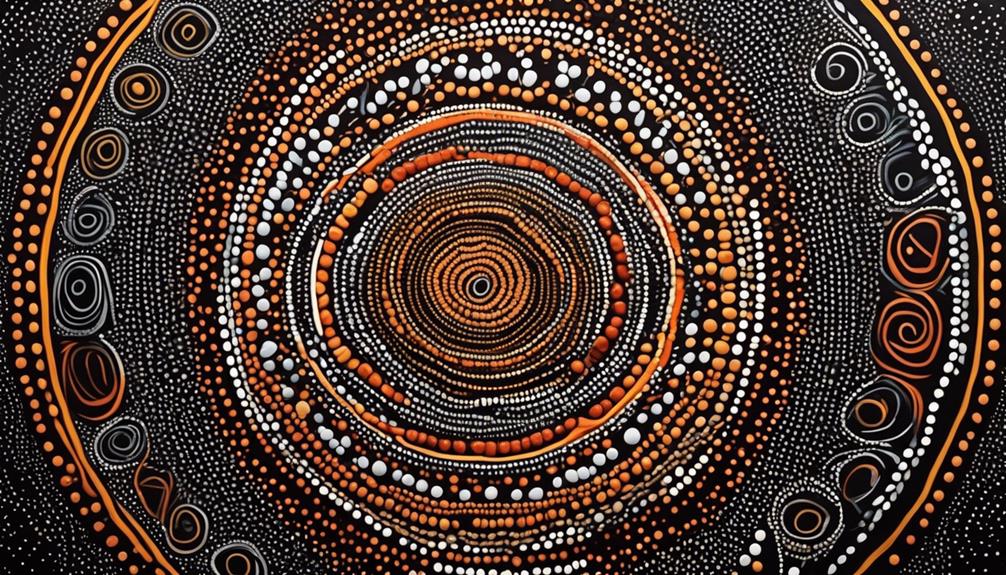
Aboriginal symbols hold profound cultural significance, embodying an intricate tapestry of beliefs, traditions, and spiritual connections that have been passed down through generations. These symbols are deeply intertwined with cultural practices and spiritual beliefs, playing a pivotal role in expressing and preserving the rich cultural heritage of Aboriginal communities.
Here's why they're so crucial:
1) Cultural Identity: Aboriginal symbols serve as a visual language, communicating stories, rituals, and customs that are integral to maintaining the cultural identity of Aboriginal peoples.
2) Connection to the Land: These symbols often represent the deep spiritual connection that Aboriginal communities have with the land, encapsulating their reverence for the natural world and their role as custodians of the earth.
3) Passing Down Knowledge: Through these symbols, ancestral knowledge, history, and wisdom are transmitted from one generation to the next, ensuring the continuity of cultural practices and spiritual beliefs.
4) Ceremonial Significance: Many symbols are used in ceremonial contexts, playing a vital role in spiritual rituals, initiations, and other sacred practices, reinforcing their significance in Aboriginal cultural and spiritual life.
Understanding the cultural significance of these symbols is crucial in appreciating the depth of Aboriginal traditions and the spiritual beliefs that underpin them.
Preservation and Evolution of Aboriginal Symbols
Preserving and evolving Aboriginal symbols is essential in ensuring the continuity of cultural practices and spiritual beliefs, while also embracing the potential for adaptation and growth within these sacred traditions.
The preservation of Aboriginal symbols is crucial for maintaining the integrity of their cultural heritage. It involves safeguarding the knowledge and meanings associated with these symbols, ensuring that they're passed down through generations intact.
Simultaneously, the evolution of these symbols is necessary to ensure their relevance in contemporary society. As cultures and societies evolve, so too must their symbols, allowing for the adaptation of traditional meanings to modern contexts.
The evolution of Aboriginal symbols also involves the exploration of new artistic expressions and mediums, enabling these symbols to remain dynamic and meaningful in today's world. This process honors the rich history and significance of these symbols while allowing them to resonate with current generations.
It's a delicate balance between preservation and adaptation, where the essence of the symbols remains unchanged, yet their forms may evolve to stay relevant. By carefully navigating this balance, Aboriginal symbols can continue to hold deep cultural and spiritual significance while also remaining pertinent in an ever-changing world.
Frequently Asked Questions
How Have Modern Aboriginal Communities Adapted Traditional Symbols for Contemporary Use?
In modern Aboriginal communities, traditional symbols have been adapted for contemporary use through interpretation and cultural practices. This adaptation reflects the ongoing evolution of Aboriginal culture, embracing new forms of expression while maintaining the integrity of the symbols.
Are There Specific Rules or Protocols for the Use of Aboriginal Symbols in Art and Cultural Expression?
When using Aboriginal symbols in art and cultural expression, it's crucial to be mindful of cultural appropriation and the symbolic representation they hold. Respectful use involves understanding specific rules and protocols, often passed down through generations.
It's important to seek permission and guidance from Aboriginal communities when incorporating these symbols, honoring their significance and ensuring the representation is authentic and respectful.
How Do Different Aboriginal Groups Interpret and Use Symbols in Their Cultural Practices?
In interpreting symbols, different Aboriginal groups infuse cultural practices with rich meanings. Symbol adaptation is a dynamic process, integrating traditional and contemporary use.
For instance, the interpretation of symbols can vary across communities, reflecting unique histories and belief systems. Understanding these nuances is crucial for respectful engagement with Indigenous cultures.
What Are Some Lesser-Known Aboriginal Symbols and Their Meanings?
Looking for some obscure Aboriginal symbols and their meanings?
Dive into the rich world of Aboriginal art and uncover the profound symbolism hidden within Dreamtime stories.
These lesser-known symbols carry deep cultural significance and offer a fascinating glimpse into the diverse narratives and traditions of Aboriginal communities.
Delve into the intricate meanings behind these symbols to gain a deeper understanding of the profound connection between art, storytelling, and Aboriginal culture.
How Has the Meaning and Significance of Aboriginal Symbols Evolved Over Time?
The evolution of symbolism in Aboriginal culture has been a fascinating journey, with meanings and significance adapting to changing times.
Cultural adaptation has played a significant role, allowing symbols to remain relevant while embracing new influences.
As society has evolved, so have the meanings behind these symbols, reflecting the ongoing connection between the Aboriginal people and their heritage.
This evolution demonstrates the resilience and adaptability of Aboriginal symbolism in the face of changing cultural landscapes.
Conclusion
As you explore the rich tapestry of Aboriginal symbols, you'll uncover a world of meaning and significance woven into each intricate design.
Like a vibrant mosaic, these symbols tell the story of a culture that's both ancient and ever-evolving, inviting you to appreciate the beauty and depth of their traditions.
Keep exploring and you'll find yourself on a journey of discovery, unlocking the secrets and wisdom encapsulated in these timeless symbols.
Nayeli is our dedicated Editor in Chief, bringing her passion for words and keen editorial eye to every piece of content we produce. With years of experience in the field, she ensures that every article and publication meets the highest standards of quality and clarity. Nayeli’s commitment to storytelling and her deep understanding of our mission make her an invaluable leader in our team.

